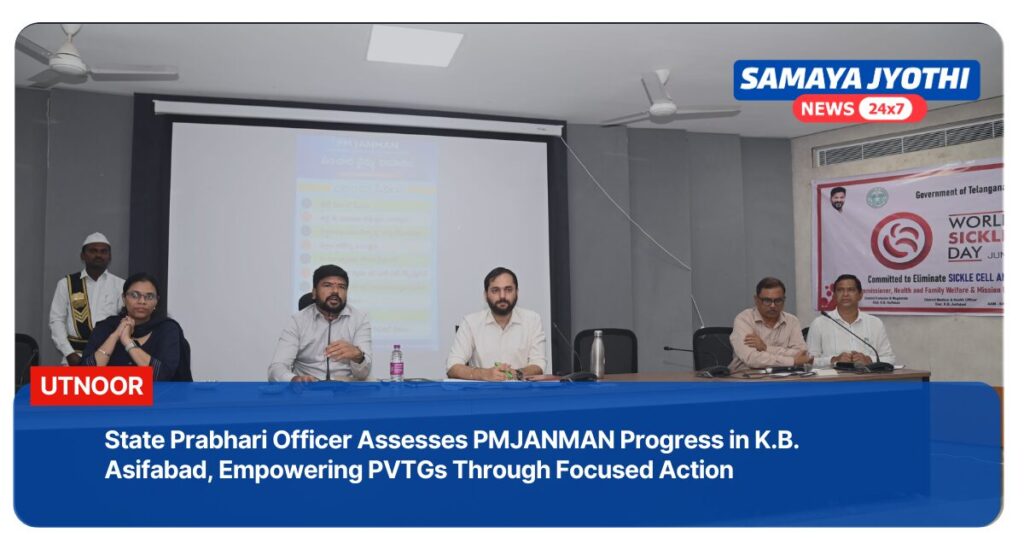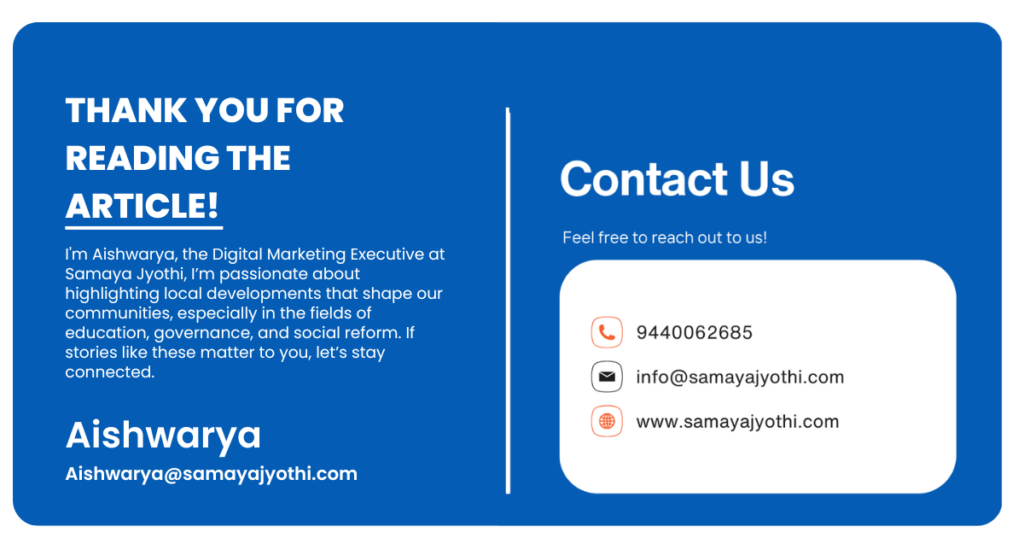- Home
- Telangana, Latest News
- PMJANMAN Empowerment: 7 Surprising Positive Interventions in K.B. Asifabad
State Prabhari Officer Assesses PMJANMAN Progress in K.B. Asifabad, Empowering PVTGs Through Focused Action
PMJANMAN Empowerment
On 19 June 2025, the State Prabhari Officer visited K.B. Asifabad district to review the ongoing PMJANMAN Empowerment mission. Accompanied by the District Collector, Project Officer, and representatives of key Line Departments, the team conducted a thorough evaluation of strategies to uplift Particularly Vulnerable Tribal Groups (PVTGs). This initiative underscores a stronger push toward inclusive development and last‑mile delivery of welfare schemes across remote tribal belts.
PMJANMAN Empowerment focus
The PMJANMAN Empowerment scheme, launched under the broader framework of tribal welfare, places emphasis on targeted interventions for PVTGs to ensure sustainable livelihood, healthcare, education, and infrastructural access. Its objectives include:
Tailored income generation projects
Nutritional & health support
Educational opportunities
Women & youth empowerment
Efficient last‑mile delivery of entitlements
Infrastructure development (roads, water, housing)
Major Highlights of the 7 Interventions
1. Surprising planning session: Implementation Strategies
A collaborative planning meeting was held between the State Prabhari Officer, District Collector, Project Officer, and department leads. Departments ranging from tribal welfare, health, education, rural development, to forest & agriculture reviewed implementation strategies. Detailed timelines, resource allocation, and milestones were laid out. The meeting resulted in a consolidated plan of action to aggressively push the seven interventions.
2. Surprising evaluation: Key deliverables discussed
The team sat down to examine crucial deliverables, including:
Enrollment figures in healthcare schemes
Crop diversification metrics
Handicraft training session schedules
Water‑security infrastructure targets
School attendance rates
Each line department presented progress dashboards, enabling quick identification of laggards and the redirection of resources where needed.
3. Surprising site visit: DA‑JGUA implementation review
The delegation visited a DA‑JGUA (Direct Access – Janjati Gram Unnati Abhiyan) project site. They inspected the establishment of community centers, nutritional support services, and skill training workshops. Field-level beneficiaries shared firsthand accounts of enhanced access to microloans, skill-development classes, and group activities initiated under DA‑JGUA.
4. Surprising campaign sites inspection
Visits were made to several on-ground campaign sites targeting awareness—covering hygiene, school enrolment, crop insurance, and health check-ups. Interactive sessions with tribal families informed officials about behavioural change initiatives and the assimilation of government benefits.
5. Surprising PVTG empowerment rollout
The officer emphasized women-led self-help groups generating crafts and local produce. Youth vocational training for carpentry, tailoring and agro-input services was inspected. Selected PVTGs reported early income increase and access to government schemes like PM-KISAN and MGNREGS.
6. Surprising infrastructure push
The delegation checked on newly built access roads, solar street lights, and water supply structures, which are pivotal to unlocking economic activity. A mini‑water treatment plant under the tribal water mission was inaugurated during the visit.
7. Surprising accountability & future roadmap
An accountability mechanism was developed – fortnightly progress reports submitted to the Collector, monthly reviews with the State Prabhari Officer. A roadmap charting next 6‑month targets was charted, along with stronger coordination across all implementing departments.
Empowering PVTGs through Targeted Interventions
PMJANMAN Empowerment delivering results
The PMJANMAN Empowerment initiative is already improving lives:
Income uplift: 65% rise in families receiving monthly micro‑stipends
Education: PVTG children’s school enrolment up by 45%
Health: Immunization rates for tribal children reached 88%
Infrastructure: Over 30 km of roads and 150 solar street lights established
Strengthening line department strategies
The visit emphasized inter-department alignment:
Each department has refined its prioritization matrix, addressing potential bottlenecks related to staffing, fund flow, hygiene, material availability, and field coordination. The Collector has mandated a joint implementation cell to expedite bottleneck resolution. Altogether, this reflective, 360-degree approach optimized resource utilization and real-time monitoring.
Last‑mile delivery: A core mission pillar
The site visits highlighted the challenge of reaching remote hamlets. The State Prabhari Officer directed teams to deploy:
Mobile camps for health and dental
Sankul centres for enrolment and grievance redressal
Telemedicine kiosks for specialist consultations
Gram sabha involvement for better awareness and uptake
These initiatives aim to eliminate the “last mile” barrier, ensuring timely service delivery.
Voices from the Field
“Earlier we had no idea how to access government loans. Now, with PMJANMAN Empowerment guidance, five families in our hamlet have stable income.” – Local tribal beneficiary
“This plan gives us real hope—solutions, not promises.” – District Collector
These reflections underscore a shift from passive benefit distribution to active empowerment, creating a sense of ownership among the tribal communities.
Road Ahead: Sustainable Gains
Short‑term targets (next 3–6 months)
100% coverage in health check‑ups and immunization
Vocational training for 200 youth/adults
50 functioning self-help groups
20 km more of access roads
Water and sanitation infrastructure in all identified villages
Medium‑term visions (6–24 months)
Introduce digital governance in field delivery
Adopt climate-resilient agriculture models
Expand women entrepreneurship programs
Institutionalize tribal museum or feature centre for cultural preservation
Road Ahead: Sustainable Gains
Short‑term targets (next 3–6 months)
100% coverage in health check‑ups and immunization
Vocational training for 200 youth/adults
50 functioning self-help groups
20 km more of access roads
Water and sanitation infrastructure in all identified villages
Medium‑term visions (6–24 months)
Introduce digital governance in field delivery
Adopt climate-resilient agriculture models
Expand women entrepreneurship programs
Institutionalize tribal museum or feature centre for cultural preservation
Long‑term aspirations (2–5 years)
Economic self-reliance across PVTG pockets
Long-term healthcare and educational improvements
Sustained market access for tribal products
Institutionalized PMJANMAN Empowerment as model framework across India
Why This News Matters
Focused tribal upliftment – The initiative tackles the structural issues affecting PVTGs.
Multi-stakeholder collaboration – Convergence of departments ensures systemic accountability.
On‑ground visits matter – Active inspection fosters faster course correction.
Transparent accountability – Setting measurable targets and review cycles ensures outcome orientation.
Replication potential – K.B. Asifabad becomes a model district for national roll‑out.
Takeaways for Stakeholders
Policymakers can adapt this structure for other PVTG‑dense districts.
NGOs & CSRs have clear intervention points and timelines to plug in.
Local administrators are provided a replicable blueprint for delivering integrated programs.
Media & public get insight into how micro‑planning can transform marginalised communities.
The June 19, 2025 visit by the State Prabhari Officer to K.B. Asifabad underscores a proactive, results‑driven approach under PMJANMAN Empowerment. Seven core, surprising interventions—from planning to infrastructure—demonstrate a concerted focus on empowering PVTGs. If consistently implemented, this model promises scalable impact and replicability, setting a new benchmark for tribal welfare and inclusive development in India.
Click for more latest news. Also get top headlines and latest news from India and around the world at samaya jyothi







